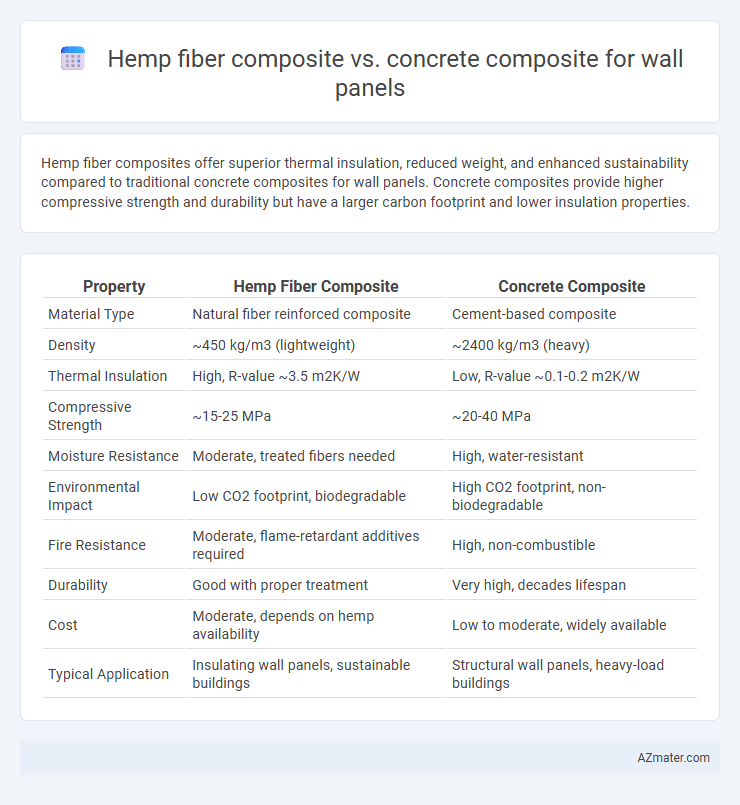Hemp fiber composites offer superior thermal insulation, reduced weight, and enhanced sustainability compared to traditional concrete composites for wall panels. Concrete composites provide higher compressive strength and durability but have a larger carbon footprint and lower insulation properties.
Table of Comparison
| Property | Hemp Fiber Composite | Concrete Composite |
|---|---|---|
| Material Type | Natural fiber reinforced composite | Cement-based composite |
| Density | ~450 kg/m3 (lightweight) | ~2400 kg/m3 (heavy) |
| Thermal Insulation | High, R-value ~3.5 m2K/W | Low, R-value ~0.1-0.2 m2K/W |
| Compressive Strength | ~15-25 MPa | ~20-40 MPa |
| Moisture Resistance | Moderate, treated fibers needed | High, water-resistant |
| Environmental Impact | Low CO2 footprint, biodegradable | High CO2 footprint, non-biodegradable |
| Fire Resistance | Moderate, flame-retardant additives required | High, non-combustible |
| Durability | Good with proper treatment | Very high, decades lifespan |
| Cost | Moderate, depends on hemp availability | Low to moderate, widely available |
| Typical Application | Insulating wall panels, sustainable buildings | Structural wall panels, heavy-load buildings |
Introduction to Hemp Fiber and Concrete Composites
Hemp fiber composites incorporate natural fibers derived from the hemp plant, offering lightweight, durable, and eco-friendly alternatives for wall panel construction. Concrete composites, primarily composed of cement, aggregates, and additives, provide high strength, thermal mass, and fire resistance but involve higher carbon emissions during production. The choice between hemp fiber and concrete composites impacts sustainability, insulation properties, and structural performance in building applications.
Material Properties: Hemp Fiber vs Concrete
Hemp fiber composites offer superior thermal insulation, lower density, and enhanced flexibility compared to concrete composites, which are known for their high compressive strength and durability but greater weight and brittleness. The low thermal conductivity of hemp fiber composites improves energy efficiency in wall panels, while concrete composites provide excellent fire resistance and load-bearing capacity. Hemp fiber's natural hygroscopic properties contribute to better moisture regulation, unlike concrete composites that may suffer from cracking due to shrinkage and moisture-related stress.
Environmental Impact and Sustainability
Hemp fiber composites significantly reduce environmental impact by sequestering carbon dioxide during hemp growth, offering a biodegradable and renewable alternative to traditional concrete composites, which rely heavily on energy-intensive cement production and emit high levels of CO2. Hemp wall panels provide superior thermal insulation and lower embodied energy, enhancing building sustainability through improved energy efficiency and reduced lifecycle emissions. The use of hemp fibers in composites promotes circular economy principles by enabling recyclability and reducing landfill waste compared to concrete-based panels that contribute to long-term environmental degradation.
Mechanical Strength and Durability Comparison
Hemp fiber composites exhibit superior tensile strength and flexibility compared to traditional concrete composites, making them less prone to cracking under stress and vibrations in wall panel applications. Concrete composites offer higher compressive strength but are susceptible to brittleness and environmental degradation, reducing long-term durability without proper additives or reinforcements. Hemp fiber composites also provide enhanced resistance to moisture and thermal expansion, contributing to improved durability and reduced maintenance requirements for exterior wall panels.
Thermal Insulation Performance
Hemp fiber composites exhibit superior thermal insulation performance compared to concrete composites due to their low thermal conductivity and high porosity, which reduce heat transfer. Concrete composites generally have higher density and thermal mass, resulting in increased heat retention but poorer insulation properties. Utilizing hemp fiber composites in wall panels enhances energy efficiency by maintaining stable indoor temperatures and reducing heating and cooling loads.
Acoustic Properties in Wall Panels
Hemp fiber composites exhibit superior acoustic properties compared to concrete composites in wall panels, offering enhanced sound absorption and noise reduction due to their porous and fibrous structure. Concrete composites, while structurally robust, have higher density and reflect more sound, resulting in lower acoustic insulation performance. Utilizing hemp fiber composites in wall panels significantly improves indoor acoustic comfort by dampening airborne noise and vibrations more effectively than concrete-based panels.
Cost Analysis and Economic Viability
Hemp fiber composites offer significant cost advantages over concrete composites for wall panels due to lower raw material prices and reduced energy consumption during production, resulting in decreased overall manufacturing expenses. The lightweight nature of hemp composites also cuts transportation and installation costs, enhancing their economic viability in construction projects. Long-term savings are further supported by hemp's improved thermal insulation properties, reducing energy costs for heating and cooling compared to traditional concrete panels.
Installation and Construction Techniques
Hemp fiber composites offer lightweight properties and flexibility, enabling quicker installation with reduced labor compared to traditional concrete composite wall panels. Construction techniques for hemp composites involve prefabrication and modular assembly, improving onsite efficiency and minimizing curing time, while concrete panels require extensive formwork, reinforcement, and longer curing periods to achieve structural integrity. The adaptability of hemp fiber composites allows integration with sustainable building systems, promoting faster, greener construction processes.
Applications and Case Studies
Hemp fiber composites offer lightweight, high insulation, and sustainability advantages for wall panels in residential and commercial buildings, demonstrated in case studies like the University of Sherbrooke's hempcrete project reducing carbon footprint. Concrete composites provide superior compressive strength and fire resistance, widely applied in high-rise construction and infrastructure with extensive validation through projects such as the Burj Khalifa facade panels. Comparative analyses show hemp composites excel in thermal performance and environmental impact, while concrete composites dominate in load-bearing applications and durability under extreme conditions.
Future Trends in Wall Panel Composites
Hemp fiber composites offer lightweight, sustainable alternatives to traditional concrete composites, exhibiting enhanced thermal insulation and carbon sequestration properties favorable for green building trends. Advancements in bio-based resin formulations and improved fiber-matrix bonding technologies are driving increased durability and structural performance in hemp fiber composite wall panels. Future trends emphasize eco-friendly, energy-efficient materials with reduced carbon footprints, positioning hemp fiber composites as key contributors to sustainable construction and circular economy objectives.

Infographic: Hemp fiber composite vs Concrete composite for Wall panel
 azmater.com
azmater.com